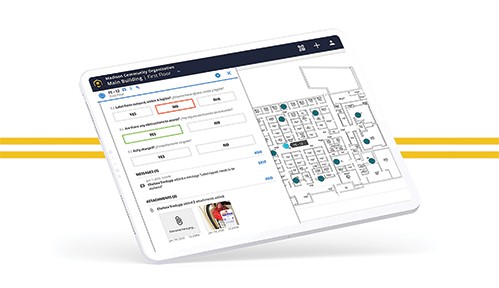By Josh Lowe
From the February 2022 Issue
If hearing the word “compliance” brings on an instant headache or feeling of dread, you’re not alone. So many facilities teams are stuck in the 1990s with obsolete technology and outdated processes. Compliance doesn’t have to be a high stress task—as long as you’re willing to change your approach. Start by evaluating your existing way of doing things. Are your tools working for you? Or against you? Following are six questions to ask about your current compliance system.

1. Can You Really Trust Your Data?
When I ask someone about the accuracy of the data in their work order management system, I’ve never once heard them reply, “It’s awesome! 100% accurate.” They usually say, “Eh, 50-50.” Compliance begins with good data.
So ask yourself:
- How are you collecting data?
- How are you recording it?
- Are you actually collecting and using all the data you need?
- Can your system handle all this data?
2. Is Your Workflow Actually Working?
Even if you have data that you can somewhat trust, it’s not of much use if it’s cumbersome to work with. How much time do you spend entering data, sorting data, finding data? Is your data connected and can you easily and quickly audit that data?
If someone pointed to an asset in your building and wanted to know when it was last inspected, when its last failure was, and how long it took from the identification of a failure to action being taken, how long would it take you to find the answers?
3. What Tools Are You Using?
What do you use to show compliance? Are you using tools actually designed for this? I see so many cases where a team has bad, incomplete, or disorganized data in a system not designed for facilities management. And they’re frustrated with their tools because they’re paying for something, but it’s not working well. It hasn’t been properly implemented and it’s not doing what they need it to do. It’s like trying to harvest corn with a lawn mower instead of a harvester. Could you do it? Probably, but it would be messy and time-consuming.
4. Are You Taking A Holistic Approach?
Compliance and assessments aren’t islands. These work together and feed into capital management and planning. Inspections are only one part of compliance. You also need to plan for, budget for, and support compliance from an overall budget infrastructure. Assessments, inspections, FCAs, and capital planning all tie into each other in one big holistic environment.
5. Do You Really Know Where All Of Your Assets Are?
Storytime: Meet Bob. If Bob isn’t around, the fire extinguisher rounds don’t get done. That’s because Bob is the only one who knows where every fire extinguisher in the building is based on the equipment list. The facility manager can’t just hand that list to someone else and say, “Go find all these fire extinguishers.” Because only Bob knows that there’s one in a specific room under the sink. No one else knows it’s there.
If you put your assets into a technology platform, then anyone can look and say, “Oh, hey, there’s 100 extinguishers to do. Bob was here earlier, he did 22 of them. But Bob got sick and went home. But I know where he left off. And I know where each one is because there’s a map and photos.”
6. Are You Ready If Compliance Standards Suddenly Changed?
Many facilities are using old methodologies and tools, yet things are changing at an exponential rate. Those old technologies are not change efficient. What happens if tomorrow, a government agency says there’s a new regulation on X type of building? Before, you just had to check fire extinguishers, but now you have to check every sprinkler head in the building every six months. How will you do that? Do you know where they all are? Can you map them? That’s a lot of data to manage without a good system.
Changes For The Better Are Here
We all have to worry about compliance and do assessments. But if you’re not using the right tools and accurate data, you’re going to struggle to prove compliance. And you’re definitely not going to be in a position to improve your facilities or prepare for new compliance requirements coming down the pipeline.

Compliance requires a paradigm shift. So many facilities teams are forced to use a 1990s interface of a database system to log work orders. For the last 20 years, many have been handed technology that wasn’t really built for them. They’re not technology people, yet they’ve had software sold to them that’s never been fully implemented.
It’s totally understandable that many are skeptical of new tools and approaches if nothing’s ever really worked out with technology in the past. You’re struggling through a pile of hot garbage that is mostly bad data.
But change is here. And it’s a good change. New technology and a new approach to data is dramatically improving facility management.
Many facilities have simple software that can’t even handle the 14 pieces of data needed to run that system. How the heck can they handle the thousands of data points required for compliance? Well, new software is floor plan-based. Picture this: you can walk into a room and refer to the floor plan to see that this room has four pumps. But wait, you just added a fifth pump last month, but it hasn’t been added to the software yet. No big deal. You can add it right now by taking a picture and clicking a button. All done.
Today’s technology is so much better, even with loads more data in it. It will actually be easier for you to maintain triple the data points with the current software capabilities than it is to maintain your original data points in the old software.
Want To Learn More About Compliance?
View This Video Webinar!
COMPLIANCE IS EVOLVING –
AND YOU’RE BEING LEFT BEHIND
Compliance doesn’t have to be a headache or something you dread – as long as you’re willing to change your approach. In this free video webinar, we discuss some of the tough — but necessary — compliance management questions facility managers need to ask themselves in 2022.
Click here to view this free video webinar now!
The Cost Of Not Making A Change
I get it. Changing the way you’ve always done things can be scary. One of the biggest benefits of not changing is not having to change anything. You can just keep going as before. But just remember that the cost of no change is far greater than the cost of change. And I’ll explain why.
Say there’s a darkly lit alley or area on your property. Your facility team has documented that this area needs more light to make it safer. But it wasn’t made a priority, so no one ever got around to it.
Not long after, someone is assaulted in that poorly lit area. Now you’re facing a lawsuit and legal liability because you have it on record that you knew the lighting was an issue, but you never allocated budget for it or created a work order for it. Your company could be on the hook for millions of dollars.
So when it comes to compliance and facility management, take a good long look at your current situation and ask yourself: “Am I making the easy decision or the right decision?”
 Lowe is Co-founder, Chief Solution Engineer at AkitaBox, a SaaS application for proactive building management. With a degree in architecture, a background in construction, and a penchant for pushing the boundaries of new technologies, Lowe is leading the way in the building industry. He literally helped write the book on Building Information Modeling (BIM) as a contributing author to “Mastering Autodesk Revit Architecture: 2011 & 2012” and has consulted on several BIM and facility management technologies. In 2016, he co-founded AkitaBox that offers a new visual way to maintain facilities that help customers improve operational efficiency and reduce risk in their facilities by delivering real-world data of customers’ built environments.
Lowe is Co-founder, Chief Solution Engineer at AkitaBox, a SaaS application for proactive building management. With a degree in architecture, a background in construction, and a penchant for pushing the boundaries of new technologies, Lowe is leading the way in the building industry. He literally helped write the book on Building Information Modeling (BIM) as a contributing author to “Mastering Autodesk Revit Architecture: 2011 & 2012” and has consulted on several BIM and facility management technologies. In 2016, he co-founded AkitaBox that offers a new visual way to maintain facilities that help customers improve operational efficiency and reduce risk in their facilities by delivering real-world data of customers’ built environments.
Do you have a comment? Share your thoughts in the Comments section below, or send an e-mail to the Editor at acosgrove@groupc.com.


















![[VIDEO] Collect Asset Data at the Speed of Walking a Building](https://facilityexecutive.com/wp-content/uploads/2024/02/maxresdefault-324x160.jpg)